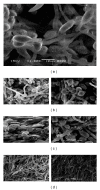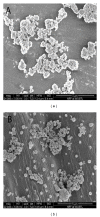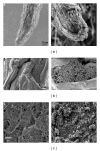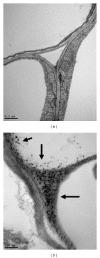Effects of engineered nanomaterials on plants growth: an overview
- PMID: 25202734
- PMCID: PMC4150468
- DOI: 10.1155/2014/641759
Effects of engineered nanomaterials on plants growth: an overview
Abstract
Rapid development and wide applications of nanotechnology brought about a significant increment on the number of engineered nanomaterials (ENs) inevitably entering our living system. Plants comprise of a very important living component of the terrestrial ecosystem. Studies on the influence of engineered nanomaterials (carbon and metal/metal oxides based) on plant growth indicated that in the excess content, engineered nanomaterials influences seed germination. It assessed the shoot-to-root ratio and the growth of the seedlings. From the toxicological studies to date, certain types of engineered nanomaterials can be toxic once they are not bound to a substrate or if they are freely circulating in living systems. It is assumed that the different types of engineered nanomaterials affect the different routes, behavior, and the capability of the plants. Furthermore, different, or even opposing conclusions, have been drawn from most studies on the interactions between engineered nanomaterials with plants. Therefore, this paper comprehensively reviews the studies on the different types of engineered nanomaterials and their interactions with different plant species, including the phytotoxicity, uptakes, and translocation of engineered nanomaterials by the plant at the whole plant and cellular level.
Figures











Similar articles
-
Toxicity, Uptake, and Translocation of Engineered Nanomaterials in Vascular plants.Environ Sci Technol. 2012 Sep 4;46(17):9224-39. doi: 10.1021/es202995d. Epub 2012 Aug 14. Environ Sci Technol. 2012. PMID: 22892035 Review.
-
Fabricated nanoparticles: current status and potential phytotoxic threats.Rev Environ Contam Toxicol. 2014;230:83-110. doi: 10.1007/978-3-319-04411-8_4. Rev Environ Contam Toxicol. 2014. PMID: 24609519 Review.
-
Effect of carbon nanomaterials on the germination and growth of rice plants.J Nanosci Nanotechnol. 2012 Mar;12(3):2212-20. doi: 10.1166/jnn.2012.5775. J Nanosci Nanotechnol. 2012. PMID: 22755040
-
Applications of carbon nanomaterials in the plant system: A perspective view on the pros and cons.Sci Total Environ. 2019 Jun 1;667:485-499. doi: 10.1016/j.scitotenv.2019.02.409. Epub 2019 Feb 27. Sci Total Environ. 2019. PMID: 30833247 Review.
-
Phytotoxicological effects of engineered nanoparticles: An emerging nanotoxicology.Sci Total Environ. 2021 Dec 20;801:149809. doi: 10.1016/j.scitotenv.2021.149809. Epub 2021 Aug 21. Sci Total Environ. 2021. PMID: 34467935 Review.
Cited by
-
Silicon Alleviate Hypoxia Stress by Improving Enzymatic and Non-enzymatic Antioxidants and Regulating Nutrient Uptake in Muscadine Grape (Muscadinia rotundifolia Michx.).Front Plant Sci. 2021 Feb 10;11:618873. doi: 10.3389/fpls.2020.618873. eCollection 2020. Front Plant Sci. 2021. PMID: 33643333 Free PMC article.
-
Penetration and Toxicity of Nanomaterials in Higher Plants.Nanomaterials (Basel). 2015 May 26;5(2):851-873. doi: 10.3390/nano5020851. Nanomaterials (Basel). 2015. PMID: 28347040 Free PMC article. Review.
-
Effect of Fe3O4 and CuO Nanoparticles on Morphology, Genotoxicity, and miRNA Expression on Different Barley (Hordeum vulgare L.) Genotypes.ScientificWorldJournal. 2021 Feb 3;2021:6644689. doi: 10.1155/2021/6644689. eCollection 2021. ScientificWorldJournal. 2021. PMID: 33628139 Free PMC article.
-
Antibacterial and Antifungal Studies of Biosynthesized Silver Nanoparticles against Plant Parasitic Nematode Meloidogyne incognita, Plant Pathogens Ralstonia solanacearum and Fusarium oxysporum.Molecules. 2021 Apr 23;26(9):2462. doi: 10.3390/molecules26092462. Molecules. 2021. PMID: 33922577 Free PMC article.
-
Advances in nanomaterials as novel elicitors of pharmacologically active plant specialized metabolites: current status and future outlooks.RSC Adv. 2019 Dec 5;9(69):40404-40423. doi: 10.1039/c9ra08457f. eCollection 2019 Dec 3. RSC Adv. 2019. PMID: 35542657 Free PMC article. Review.
References
-
- Delgado-Ramos GC. Nanotechnology in Mexico: global trends and national implications for policy and regulatory issues. Technology in Society. 2014;37(1):4–15.
-
- Safari J, Zarnegar Z. Advanced drug delivery systems: nanotechnology of health design A review. Journal of Saudi Chemical Society. 2014;18(2):85–99.
-
- Vilela Neto OP. Intelligent computational nanotechnology: the role of computational intelligence in the development of nanoscience and nanotechnology. Journal of Computational and Theoretical Nanoscience. 2014;11(4):928–944.
-
- Dutschk V, Karapantsios T, Liggieri L, McMillan N, Miller R, Starov VM. Smart and green interfaces: from single bubbles/drops to industrial environmental and biomedical applications. Advances in Colloid and Interface Science. 2014;209:109–126. - PubMed
Publication types
MeSH terms
LinkOut - more resources
Full Text Sources
Other Literature Sources

